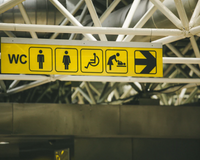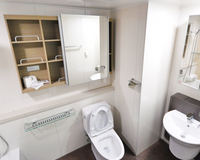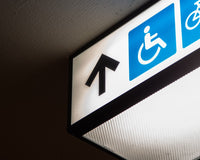Making public restrooms more accessible isn’t just a matter of meeting legal requirements; it’s also about ensuring that everyone can use the space comfortably and safely. Restrooms are essential amenities, which is why prioritizing accessibility isn’t just the ethical route to take; it also makes good business sense.
Let’s get into the details of why ADA compliance is crucial in commercial restrooms, the benefits compliance brings, the common pitfalls to watch out for, and the steps you can take to create an accessible and welcoming space in your building.
Understanding ADA Compliance
The Americans with Disabilities Act (ADA), signed into law in 1990, is a civil rights legislation that prohibits discrimination based on disability. It ensures equal opportunities for individuals with disabilities in public accommodations, employment, transportation, and other essential areas.
Public and commercial properties, including restrooms, fall under the scope of the ADA. It requires businesses to make reasonable accommodations to meet accessibility standards.
While the ADA is a piece of legislature, it’s about much more than legal compliance. It represents the societal commitment to creating spaces that accommodate all individuals equally. Commercial restrooms, which are used daily by hundreds to thousands of people, play a key role in ensuring accessibility in public spaces.
Key Requirements for Restrooms
ADA compliance in restrooms requires contractors, facility managers, and business owners to adhere to stringent guidelines that remove barriers to accessibility.
Examples of common requirements include:
- Proper stall dimensions to allow wheelchair access
- Doors that are easy to open, with handles that can be operated with one hand and do not require tight grasping or twisting
- Accessible signage with braille and raised lettering
- Sinks and faucets installed at appropriate heights for individuals using wheelchairs
- Grab bars in stalls to provide support and improve usability
By meeting these requirements, businesses make their restrooms more accessible for a diverse range of individuals, including those with mobility issues, visual impairments, and other disabilities.

Who Benefits From ADA Compliance?
Accessible restrooms benefit everyone in meaningful ways. Here are some of the key groups affected by ADA-compliant spaces.
Individuals With Disabilities
When restrooms meet accessibility guidelines, they empower individuals with disabilities to confidently and independently use facilities without feeling excluded. This helps preserve dignity and ensure everyone has convenient access.
For example, if a wheelchair user visiting a public building doesn’t have access to a restroom that accommodates their needs, it can lead to discomfort and frustration. ADA-compliant restrooms address these barriers, creating seamless experiences for all visitors.
Business Owners
Although meeting ADA-compliance standards requires an investment of time and resources, the benefits for businesses far outweigh the initial effort. Making your commercial space accessible means you’re more likely to attract and retain customers who appreciate businesses committed to inclusivity.
Additionally, ADA compliance reduces the risk of legal complications. Lawsuits stemming from noncompliance are expensive and can damage a business’s reputation. Proactively building ADA-compliant spaces reflects business owners’ ethical commitments while also reducing financial risks.
Broader Communities
Many accessibility features in public spaces also assist parents, children, and older adults. As a result, accessibility fosters a sense of connection and inclusivity within larger communities. When businesses provide restrooms that accommodate individuals with disabilities, they support a culture in which everyone feels respected and valued. The larger ripple effect is a more inclusive society where accessibility is woven into the fabric of public spaces.
Common ADA Violations in Commercial Restrooms
Even with the best intentions, commercial property owners can easily fall short of meeting ADA standards if they don’t pay close attention to the details. Here are some of the most common violations, many of which can be avoided by checking for ADA updates on a yearly basis.
Signage
Signs may lack critical features, such as raised lettering and braille, which are necessary for individuals with visual impairments. Additionally, improper placement can make signage inaccessible for certain users. Signs need to be mounted at the correct height and easily visible to all visitors.
Stall Dimensions
Many restrooms fail to include stalls large enough to accommodate wheelchairs. ADA-compliant stalls need to provide adequate space for maneuvering and must include support bars to assist users in safely transferring from a wheelchair to the toilet.
Faucet and Sink Heights
Sometimes, a small detail such as the installation height of a sink or faucet can result in major accessibility barriers. If sinks are mounted too high or if faucets require tight grasping or twisting to operate, certain users will struggle or be unable to use them at all.

Consequences of Noncompliance
Failing to prioritize ADA compliance has several negative consequences for businesses. Noncompliance exposes businesses to lawsuits and the considerable costs associated with them.
The impact also goes beyond financial repercussions. Noncompliant businesses may face persistent damage to their reputations, being seen as neglectful or discriminatory against individuals with disabilities.
On a practical level, ignoring ADA compliance could mean losing potential customers, employees, or business partners who consider inclusiveness nonnegotiable. Prioritizing accessibility can increase customer loyalty and goodwill.
Steps To Ensure ADA Compliance
Making commercial restrooms ADA-compliant requires intentionality and expertise. By following these steps, you’ll create an accessible space while avoiding mishaps.
Conduct an Audit
The first step is to assess your existing restrooms and determine whether they meet ADA standards. If your building was constructed before 1990, it’s considered an existing building, and modifications may be necessary. Bring in experts who specialize in accessibility audits to evaluate what changes are needed.
Consult With Experts
Architects and contractors with expertise in ADA compliance can provide insight during renovations or the construction of new facilities. Their knowledge will ensure all details, from sink height to stall configuration, meet legal standards, saving you headaches down the line.
Train Your Staff
Compliance doesn’t end with design and construction. Facility managers should be equipped with the knowledge to maintain compliance and resolve accessibility issues as needed.
Resources for Further Information
For those looking to go deeper into understanding ADA compliance, the official ADA Standards for Accessible Design provide an exhaustive guide to all necessary requirements. Organizations such as the US Access Board offer training, webinars, and design guides tailored to various industries.
By prioritizing accessibility in your commercial restroom facilities, you can empower individuals with disabilities, demonstrate your business’s values, and contribute to your community. That’s why ADA compliance is crucial in commercial restrooms.
If you’re in need of commercial bathroom products, Choice Builder Solutions can help. Reach out to us today to learn how our products can ensure ADA compliance.





